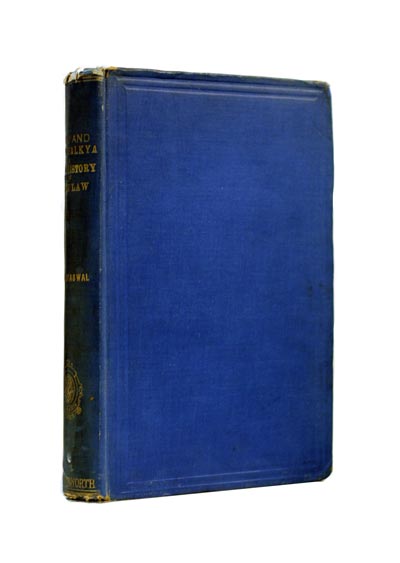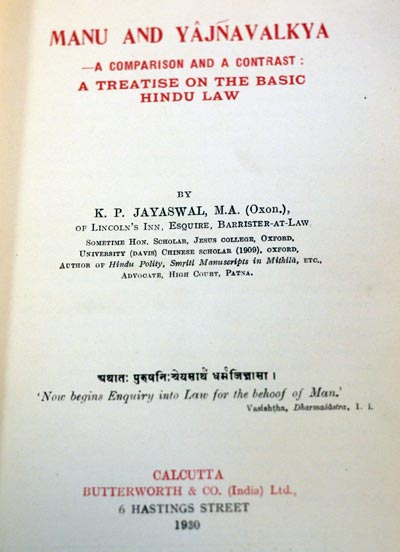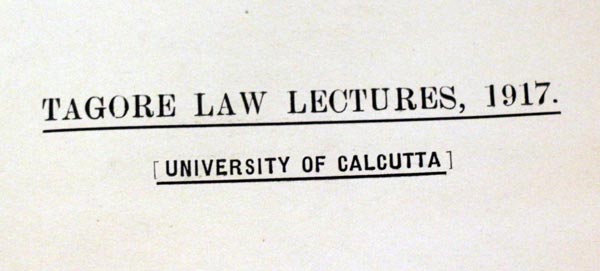About the author:
Kashi Prasad Jayaswal (27 November 1881 – 4 August 1937) was an Indian historian and lawyer. One of the intellectual forces behind the Indian nationalist movement, Jayaswal’s works ‘Hindu Polity’ (1918) and ‘History of India, 150 A.D. to 350 A.D.’ (1933) are classics of ancient Indian historical literature. Among other things, Jayaswal is credited with showing that Indian republics, based on the principles of representation and collective decision-making, were among the oldest and most powerful of the ancient world.
Jayaswal was born in Mirzapur, Uttar Pradesh, and graduated from Allahabad University. He went on to Jesus College, Oxford University, where he was awarded the Davis Scholarship in Chinese and graduated with a M.A. in Ancient Indian History in 1909. He was called to the Bar of Lincoln’s Inn in London in 1910. After returning to India, Jayaswal set up practice at the Calcutta High Court, where he came into contact with Sir Ashutosh Mukherjee, who inspired Jayaswal to undertake further research in ancient Indian history. Jayaswal moved to Patna in 1916, and remained there permanently.
A prolific scholar, Jayaswal wrote more than 120 research papers in addition to 11 books and numerous commentaries and translations. He also played a pioneering role in excavating and restoring ancient sites, including the university of Nalanda in modern Bihar. He was also an expert in Numismatics, and his discovery of several coins of the Maurya and Gupta periods led to his being the first Indian to be invited to speak at the Royal Asiatic Society of London in 1931. Jayaswal was twice elected president of the Numismatic Society of India, and was awarded the degree of Doctor of Philosophy (Honoris Cause) by Benares Hindu University and Patna University.
The Manusmṛti
The Manusmṛti (Sanskrit: मनुस्मृति), also spelled as Manusmriti, is the most important and most studied ancient legal text among the many Dharmaśāstras of Hinduism. It was one of the first Sanskrit texts translated during the British rule of India in 1794, by Sir William Jones, and used to formulate the Hindu law by the colonial government.
Over fifty manuscripts of Manusmriti are now known, but the earliest discovered, most translated and presumed authentic version since the 18th-century has been the “Calcutta manuscript with Kulluka Bhatta commentary”. Modern scholarship states this presumed authenticity is false, and the various manuscripts of Manusmriti discovered in India are inconsistent with each other, and within themselves, raising concerns of its authenticity, insertions and interpolations made into the text in later times.
The metrical text is in Sanskrit, is variously dated to be from 2nd century BCE to 3rd century CE, and it presents itself as a discourse given by Manu and Bhrigu on dharma topics such as duties, rights, laws, conduct, virtues and others. The text’s fame spread outside India, long before the colonial era. The medieval era Buddhistic law of Myanmar and Thailand are also ascribed to Manu, and the text influenced past Hindu kingdoms in Cambodia and Indonesia.
Manusmriti is also called the Mānava-Dharmaśāstra or Laws of Manu.
The Yājñavalkya Smṛti
The Yājñavalkya Smṛti is a Hindu text of the Dharmaśāstra tradition. It has been called the “best composed” and “most homogeneous” specimen of this genre.
The Yājñavalkya Smṛti consists of 1,010 ślokas (verses). The text is laid out as a frame story in which the sages of Mithila approach Yājñavalkya and ask him to teach them dharma. The majority of the text is then Yājñavalkya’s description of dharma, divided into three subtopics: Ācāra (proper conduct), Vyavahāra (judicial procedures) and Prāyaścitta (penance).
It is clear that the text draws heavily on the Manu Smrti, sometimes directly paraphrasing passages. There are influential deviations from the Manu Smrti as well, especially with regard to statecraft and jurisprudence.
1. Pioneered the structure which was adopted in future dharmaśāstric discourse:
a)Divided dharma into fairly equally weighted categories of:
Ācāra (proper conduct)
Vyavahāra (legal procedure)
Prāyaścitta (penance)
b)Subdivided these three further by specific topics within the major subject heading.
2. Added to the model of Legal Procedure:
Yājñavalkya portrayed evidence as hierarchical, with documents receiving the highest consideration, then witnesses, and finally the five types of ordeals.
3. Restructured the Courts:
Yājñavalkya distinguished between courts appointed by the king and those which were formed by communities of intermediate groups. He then portrayed these courts as a part of a system of hierarchical appeals.
4. Changed the placement of the discussion of Ascetic Orders:
Forest hermits and renouncers are discussed within the section regarding penance (prāyaścitta). In previous texts, description of ascetics followed the discussion of Brahmins and framed them in opposition to householder Brahmins. The placement of ascetic orders within penance remained in subsequent texts following the general acceptance of the Yājñavalkya Smṛti.
5. Focused on Mokṣa:
Increased attention was given to a description of Mokṣa, dwelling on meditation and the transience of the worldly body. There is even an in-depth, technical discourse based on a medical treatise of the time.
(from wikipedia)




